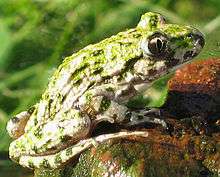Pelodytidae
Pelodytidae, also known as the parsley frogs, or rarely, mud divers, is a family of frogs. It contains a single extant genus, Pelodytes,[2][3][4][5] and two genera only known from fossils.[1][4] The extant species are found in southwestern Europe and the Caucasus.[2][3][5]
| Pelodytidae | |
|---|---|
 | |
| Pelodytes punctatus | |
| Scientific classification | |
| Kingdom: | Animalia |
| Phylum: | Chordata |
| Class: | Amphibia |
| Order: | Anura |
| Superfamily: | Pelobatoidea |
| Family: | Pelodytidae Bonaparte, 1850 |
| Type genus | |
| Pelodytes Bonaparte, 1838 | |
| Synonyms[2] | |
| |
Genera
- Pelodytes Bonaparte, 1838 – 5 species, southwestern Europe and the Caucasus[2][3]
- †Miopelodytes Taylor, 1941 – 1 species, North America[6]
- †Tephrodytes Henrici, 1994 – 1 species, North America[7]
Evolutionary relationships
Most recent studies suggests that Pelodytidae belongs to a clade containing three other families: Pelobatidae, Scaphiopodidae, and Megophryidae.[4][5] Its sister taxon is the clade Pelobatidae+Megophryidae,[2][5] although older studies have suggested also other relationships.[2]
Description
Modern pelodytids are moderately small frogs measuring 30–55 mm (1.2–2.2 in) in snout–vent length. The eyes have rounded but vertically oriented pupils. The finger and the toe tips are blunt to pointed. The tadpoles have keratinized mouthparts. The family is also characterized by a number of anatomical and sceletal features,[5] including the fusion of the tibiale and fibulare that have been used to include the fossil taxa Miopelodytes and Tephrodytes in this family.[4]
References
- "Pelodytidae Cope 1866". Paleobiology Database. Fossilworks. Retrieved 10 May 2020.
- Frost, Darrel R. (2020). "Pelodytidae Bonaparte, 1850". Amphibian Species of the World: an Online Reference. Version 6.1. American Museum of Natural History. doi:10.5531/db.vz.0001. Retrieved 10 May 2020.
- "Pelodytidae". AmphibiaWeb. University of California, Berkeley. 2020. Retrieved 10 May 2020.
- Blackburn, D.C. & Wake, D.B. (2011). "Class Amphibia Gray, 1825. In: Zhang, Z.-Q. (Ed.) Animal biodiversity: An outline of higher-level classification and survey of taxonomic richness" (PDF). Zootaxa. 3148: 39–55.
- Vitt, Laurie J. & Caldwell, Janalee P. (2014). Herpetology: An Introductory Biology of Amphibians and Reptiles (4th ed.). Academic Press. pp. 478–479.
- "†Miopelodytes Taylor 1941". Paleobiology Database. Fossilworks. Retrieved 9 May 2020.
- "†Tephrodytes Henrici 1994". Paleobiology Database. Fossilworks. Retrieved 9 May 2020.